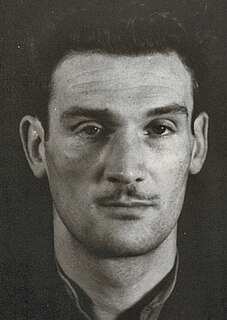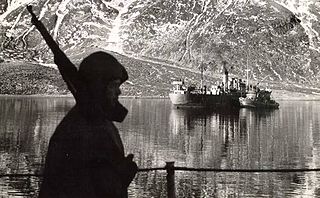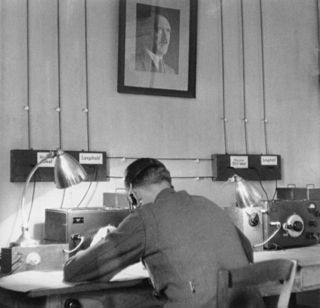Related Research Articles
Espionage, spying or intelligence gathering is the act of obtaining secret or confidential information (intelligence) from non-disclosed sources or divulging of the same without the permission of the holder of the information for a tangible benefit. A person who commits espionage is called an espionage agent or spy. Any individual or spy ring, in the service of a government, company, criminal organization, or independent operation, can commit espionage. The practice is clandestine, as it is by definition unwelcome. In some circumstances, it may be a legal tool of law enforcement and in others, it may be illegal and punishable by law.

The Office of Strategic Services (OSS) was the intelligence agency of the United States during World War II. The OSS was formed as an agency of the Joint Chiefs of Staff (JCS) to coordinate espionage activities behind enemy lines for all branches of the United States Armed Forces. Other OSS functions included the use of propaganda, subversion, and post-war planning.
The Double-Cross System or XX System was a World War II counter-espionage and deception operation of the British Security Service. Nazi agents in Britain – real and false – were captured, turned themselves in or simply announced themselves, and were then used by the British to broadcast mainly disinformation to their Nazi controllers. Its operations were overseen by the Twenty Committee under the chairmanship of John Cecil Masterman; the name of the committee comes from the number 20 in Roman numerals: "XX".

Juan Pujol Garcia, also known as Joan Pujol Garcia, was a Spanish spy who acted as a double agent loyal to Great Britain against Nazi Germany during World War II, when he relocated to Britain to carry out fictitious spying activities for the Germans. He was given the codename Garbo by the British; their German counterparts codenamed him Alaric and referred to his non-existent spy network as "Arabal".

Edward Arnold Chapman was an English criminal and wartime spy. During the Second World War he offered his services to Nazi Germany as a spy and subsequently became a British double agent. His British Secret Service handlers codenamed him Agent Zigzag in acknowledgement of his erratic personal history.

Operation Fortitude was the code name for a World War II military deception employed by the Allied nations as part of an overall deception strategy during the build-up to the 1944 Normandy landings. Fortitude was divided into two sub-plans, North and South, with the aim of misleading the German High Command as to the location of the invasion.

The Security Service, also known as MI5, is the United Kingdom's domestic counter-intelligence and security agency and is part of its intelligence machinery alongside the Secret Intelligence Service (MI6), Government Communications Headquarters (GCHQ), and Defence Intelligence (DI). MI5 is directed by the Joint Intelligence Committee (JIC), and the service is bound by the Security Service Act 1989. The service is directed to protect British parliamentary democracy and economic interests and to counter terrorism and espionage within the United Kingdom (UK).
XU was a clandestine intelligence organisation working on behalf of Allied powers in occupied Norway during World War II. Though its work proved invaluable for operations against German operations in Norway, most of its operations, organization, etc., were kept secret until 1988.
Arthur Graham Owens, later known as Arthur Graham White, was a British double agent for the Allies during the Second World War. He was working for MI5 while appearing to the Abwehr to be one of their agents. Owens was known to MI5 by the codename SNOW, which was chosen as a play on his last name.

Operation Pastorius was a failed German intelligence plan for sabotage inside the United States during World War II. The operation was staged in June, 1942 and was to be directed against strategic American economic targets. The operation was named by Admiral Wilhelm Canaris, chief of the German Abwehr, for Francis Daniel Pastorius, the leader of the first organized settlement of Germans in America. Fourteen other people would be charged with aiding those in charge of the operation.

The American Theater was a theater of operations during World War II including all continental American territory, and extending 200 miles (320 km) into the ocean.

Operation Elster was a German espionage mission intended to gather intelligence on U.S. military and technology facilities during World War II. The mission commenced in September 1944 with two Nazi agents sailing from Kiel, Germany on the U-1230 and coming ashore in Maine on November 29, 1944. The agents were William Colepaugh, an American-born defector to Germany, and Erich Gimpel, an experienced German intelligence operative. They spent nearly a month living in New York City, expending large amounts of cash on entertainment, but accomplishing none of their mission goals.

The Abwehr was the German military-intelligence service for the Reichswehr and the Wehrmacht from 1920 to 1944. Although the 1919 Treaty of Versailles prohibited the Weimar Republic from establishing an intelligence organization of their own, they formed an espionage group in 1920 within the Ministry of Defence, calling it the Abwehr. The initial purpose of the Abwehr was defence against foreign espionage: an organizational role which later evolved considerably. Under General Kurt von Schleicher the individual military services' intelligence units were combined and, in 1929, centralized under Schleicher's Ministeramt within the Ministry of Defence, forming the foundation for the more commonly understood manifestation of the Abwehr.

Gunvald Jørg Tomstad was a major agent of the British SIS, and a Norwegian resistance member during World War II. From 1941 to 1943, he was a mole or double agent while also operating a clandestine radio transmitter in the Flekkefjord area. These were two of the most dangerous roles in that war.

Duško Popov was a Serbian double agent who served as part of the MI6 and Abwehr during World War II. He passed off disinformation to Germany as part of the Double-Cross System while working as an agent for the Yugoslav government-in-exile in London.
Marina Lee, also known as Marina Lie was a ballerina and Nazi spy during World War II.

Spying, as well as other intelligence assessment, has existed since ancient times. In the 1980s scholars characterized foreign intelligence as "the missing dimension" of historical scholarship." Since then a largely popular and scholarly literature has emerged. Special attention has been paid to World War II, as well as the Cold War era (1947–1989) that was a favorite for novelists and filmmakers.
The Secret Intelligence Service (SIS), commonly known as MI6, is the foreign intelligence service of the United Kingdom, tasked mainly with the covert overseas collection and analysis of human intelligence in support of the UK's national security. SIS is one of the British intelligence agencies and the Chief of the Secret Intelligence Service ("C") is directly accountable to the Foreign Secretary.
Fifth Column was the name MI5, the British Security Service, gave to a World War II operation run from 1942 until at least 1947. It was initially intended to identify people who would be willing to assist Germany in the event of an invasion of the United Kingdom, but as it developed, it also acted to divert its targets away from harmful activities. Although it ended up providing information on more than 500 suspects, it was the source of conflict within MI5, and after the war ended it remained secret, with none of the targets ever aware that they had been its subject. It was revealed in a release of files to the National Archives in 2014.
The faked sabotage at De Havilland Factory was a successful British deception operation of the Second World War at the De Havilland Mosquito aircraft factory in Hatfield, England. The fake sabotage was conducted during the night of January 29-30,1943 and was designed to fool German reconnaissance aircraft into believing that a large bomb had detonated inside the factory’s power plant. With the help of Jasper Maskelyne, a professional magician, and a team of camouflage experts, replica sub-transformers were created out of wood and papier-mâché, buildings were camouflaged, and debris was littered around the plant to create the appearance from the air that it was damaged by an explosion. Eddie Chapman, a British double agent, was used to inform the Abwehr of the success of the "attack", which is what his German handlers sent him to England to do. The ruse proved successful in fooling the Abwehr, and Chapman was even awarded the Iron Cross in reward for his work.
References
- 1 2 "MI5 | Double Cross Agents". mi5.gov.uk. 2011. Archived from the original on 7 August 2011. Retrieved 14 July 2012.
- ↑ Haufler, Hervie (2014). The Spies That Never Were. United States: Open Road Media. ISBN 9781497622623.
- ↑ "Obituary : John Moe". The Daily Telegraph . London. 7 July 2001. ISSN 0307-1235. OCLC 49632006 . Retrieved 14 July 2012.